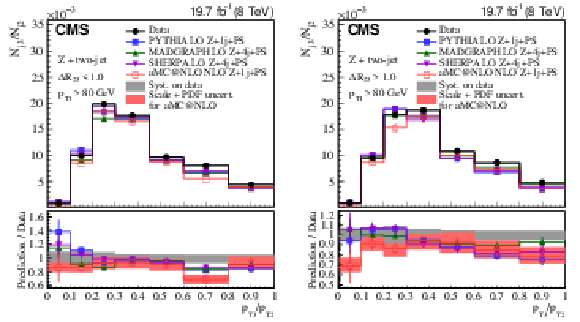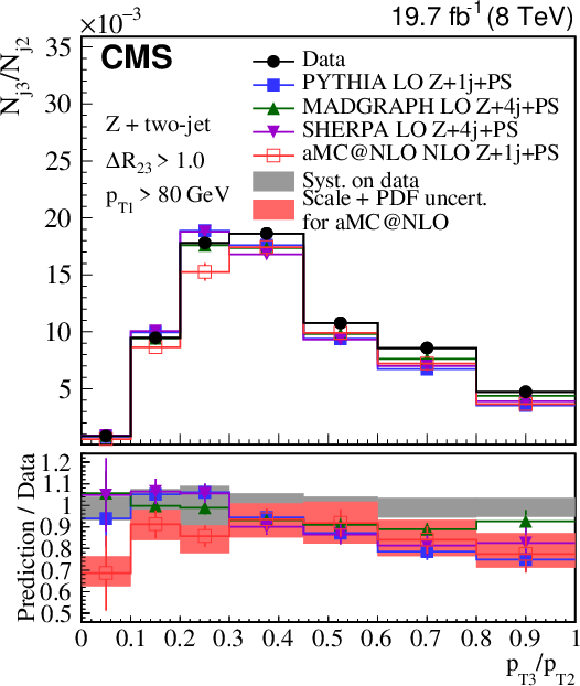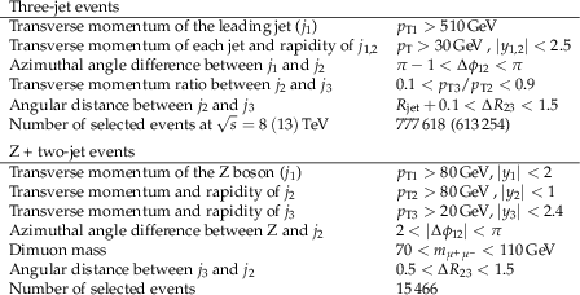

Compact Muon Solenoid
LHC, CERN
| CMS-SMP-17-008 ; CERN-EP-2020-251 | ||
| Measurements of angular distance and momentum ratio distributions in three-jet and Z $+$ two-jet final states in pp collisions | ||
| CMS Collaboration | ||
| 17 February 2021 | ||
| Eur. Phys. J. C 81 (2021) 852 | ||
| Abstract: Collinear (small-angle) and large-angle, as well as soft and hard radiations are investigated in three-jet and Z $+$ two-jet events collected in proton-proton collisions at the LHC. The normalized production cross sections are measured as a function of the ratio of transverse momenta of two jets and their angular separation. The measurements in the three-jet and Z $+$ two-jet events are based on data collected at a center-of-mass energy of 8 TeV, corresponding to an integrated luminosity of 19.8 fb$^{-1}$. The Z $+$ two-jet events are reconstructed in the dimuon decay channel of the Z boson. The three-jet measurement is extended to include $\sqrt{s} = $ 13 TeV data corresponding to an integrated luminosity of 2.3 fb$^{-1}$. The results are compared to predictions from event generators that include parton showers, multiple parton interactions, and hadronization. The collinear and soft regions are in general well described by parton showers, whereas the regions of large angular separation are often best described by calculations using higher-order matrix elements. | ||
| Links: e-print arXiv:2102.08816 [hep-ex] (PDF) ; CDS record ; inSPIRE record ; HepData record ; CADI line (restricted) ; | ||
| Figures | |

png pdf |
Figure 1:
Four categories of parton radiation. (a) soft and small-angle radiation, (b) hard and small-angle radiation, (c) soft and large-angle radiation, (d) hard and large-angle radiation. |

png pdf |
Figure 2:
Three-jet events at $\sqrt {s} = $ 8 TeV compared to theory: (left) ${p_{\mathrm{T3}} /p_{\mathrm{T2}}}$ for small-angle radiation ($ {\Delta R_{23}} < $ 1.0), (right) ${p_{\mathrm{T3}} /p_{\mathrm{T2}}}$ for large-angle radiation ($ {\Delta R_{23}} > $ 1.0). |

png pdf |
Figure 2-a:
Three-jet events at $\sqrt {s} = $ 8 TeV compared to theory: ${p_{\mathrm{T3}} /p_{\mathrm{T2}}}$ for small-angle radiation ($ {\Delta R_{23}} < $ 1.0). |

png pdf |
Figure 2-b:
Three-jet events at $\sqrt {s} = $ 8 TeV compared to theory: ${p_{\mathrm{T3}} /p_{\mathrm{T2}}}$ for large-angle radiation ($ {\Delta R_{23}} > $ 1.0). |

png pdf |
Figure 3:
Three-jet events at $\sqrt {s} = $ 8 TeV and comparison to theoretical predictions: (left) ${\Delta R_{23}}$ for soft radiation ($ {p_{\mathrm {T3}} /p_{\mathrm {T2}}} < $ 0.3), (right) ${\Delta R_{23}}$ for hard radiation ($ {p_{\mathrm {T3}} /p_{\mathrm {T2}}} > $ 0.6). |

png pdf |
Figure 3-a:
Three-jet events at $\sqrt {s} = $ 8 TeV and comparison to theoretical predictions: ${\Delta R_{23}}$ for soft radiation ($ {p_{\mathrm {T3}} /p_{\mathrm {T2}}} < $ 0.3). |

png pdf |
Figure 3-b:
Three-jet events at $\sqrt {s} = $ 8 TeV and comparison to theoretical predictions: ${\Delta R_{23}}$ for hard radiation ($ {p_{\mathrm {T3}} /p_{\mathrm {T2}}} > $ 0.6). |

png pdf |
Figure 4:
Three-jet events at $\sqrt {s} = $ 13 TeV compared to theory: (left) ${p_{\mathrm{T3}} /p_{\mathrm{T2}}}$ for small-angle radiation ($ {\Delta R_{23}} < $ 1.0), (right) ${p_{\mathrm{T3}} /p_{\mathrm{T2}}}$ for large-angle radiation ($ {\Delta R_{23}} > $ 1.0). |

png pdf |
Figure 4-a:
Three-jet events at $\sqrt {s} = $ 13 TeV compared to theory: ${p_{\mathrm{T3}} /p_{\mathrm{T2}}}$ for small-angle radiation ($ {\Delta R_{23}} < $ 1.0). |

png pdf |
Figure 4-b:
Three-jet events at $\sqrt {s} = $ 13 TeV compared to theory: ${p_{\mathrm{T3}} /p_{\mathrm{T2}}}$ for large-angle radiation ($ {\Delta R_{23}} > $ 1.0). |

png pdf |
Figure 5:
Three-jet events at $\sqrt {s} = $ 13 TeV and comparison to theoretical predictions: (left) ${\Delta R_{23}}$ for soft radiation ($ {p_{\mathrm {T3}} /p_{\mathrm {T2}}} < $ 0.3), (right) ${\Delta R_{23}}$ for hard radiation ($ {p_{\mathrm {T3}} /p_{\mathrm {T2}}} > $ 0.6). |

png pdf |
Figure 5-a:
Three-jet events at $\sqrt {s} = $ 13 TeV and comparison to theoretical predictions: ${\Delta R_{23}}$ for hard radiation ($ {p_{\mathrm {T3}} /p_{\mathrm {T2}}} > $ 0.6). |

png pdf |
Figure 5-b:
Three-jet events at $\sqrt {s} = $ 13 TeV and comparison to theoretical predictions: ${\Delta R_{23}}$ for soft radiation ($ {p_{\mathrm {T3}} /p_{\mathrm {T2}}} < $ 0.3). |

png pdf |
Figure 6:
Z $+$ two-jet events at $\sqrt {s} = $ 8 TeV compared to theory: (left) ${p_{\mathrm{T3}} /p_{\mathrm{T2}}}$ for small-angle radiation ($ {\Delta R_{23}} < $ 1.0), (right) ${p_{\mathrm{T3}} /p_{\mathrm{T2}}}$ for large-angle radiation ($ {\Delta R_{23}} > $ 1.0). |

png pdf |
Figure 6-a:
Z $+$ two-jet events at $\sqrt {s} = $ 8 TeV compared to theory: (left) ${p_{\mathrm{T3}} /p_{\mathrm{T2}}}$ for small-angle radiation ($ {\Delta R_{23}} < $ 1.0), (right) ${p_{\mathrm{T3}} /p_{\mathrm{T2}}}$ for large-angle radiation ($ {\Delta R_{23}} > $ 1.0). |

png pdf |
Figure 6-b:
Z $+$ two-jet events at $\sqrt {s} = $ 8 TeV compared to theory: (left) ${p_{\mathrm{T3}} /p_{\mathrm{T2}}}$ for small-angle radiation ($ {\Delta R_{23}} < $ 1.0), (right) ${p_{\mathrm{T3}} /p_{\mathrm{T2}}}$ for large-angle radiation ($ {\Delta R_{23}} > $ 1.0). |

png pdf |
Figure 7:
Z $+$ two-jet events at $\sqrt {s} = $ 8 TeV compared to theory: (left) ${\Delta R_{23}}$ for soft radiation ($ {p_{\mathrm {T3}} /p_{\mathrm {T2}}} < $ 0.3), (right) ${\Delta R_{23}}$ for hard radiation ($ {p_{\mathrm {T3}} /p_{\mathrm {T2}}} > $ 0.6). |

png pdf |
Figure 7-a:
Z $+$ two-jet events at $\sqrt {s} = $ 8 TeV compared to theory: (left) ${\Delta R_{23}}$ for soft radiation ($ {p_{\mathrm {T3}} /p_{\mathrm {T2}}} < $ 0.3), (right) ${\Delta R_{23}}$ for hard radiation ($ {p_{\mathrm {T3}} /p_{\mathrm {T2}}} > $ 0.6). |

png pdf |
Figure 7-b:
Z $+$ two-jet events at $\sqrt {s} = $ 8 TeV compared to theory: (left) ${\Delta R_{23}}$ for soft radiation ($ {p_{\mathrm {T3}} /p_{\mathrm {T2}}} < $ 0.3), (right) ${\Delta R_{23}}$ for hard radiation ($ {p_{\mathrm {T3}} /p_{\mathrm {T2}}} > $ 0.6). |

png pdf |
Figure 8:
Z $+$ two-jet events at $\sqrt {s} = $ 8 TeV compared to theoretical predictions from {pythia} 8 without initial-state parton showers (IPS), final-state parton showers (FPS), and MPI: (left) ${p_{\mathrm{T3}} /p_{\mathrm{T2}}}$ for small-angle radiation ($ {\Delta R_{23}} < $ 1.0), (right) ${p_{\mathrm{T3}} /p_{\mathrm{T2}}}$ for large-angle radiation ($ {\Delta R_{23}} > $ 1.0). |

png pdf |
Figure 8-a:
Z $+$ two-jet events at $\sqrt {s} = $ 8 TeV compared to theoretical predictions from {pythia} 8 without initial-state parton showers (IPS), final-state parton showers (FPS), and MPI: (left) ${p_{\mathrm{T3}} /p_{\mathrm{T2}}}$ for small-angle radiation ($ {\Delta R_{23}} < $ 1.0), (right) ${p_{\mathrm{T3}} /p_{\mathrm{T2}}}$ for large-angle radiation ($ {\Delta R_{23}} > $ 1.0). |

png pdf |
Figure 8-b:
Z $+$ two-jet events at $\sqrt {s} = $ 8 TeV compared to theoretical predictions from {pythia} 8 without initial-state parton showers (IPS), final-state parton showers (FPS), and MPI: (left) ${p_{\mathrm{T3}} /p_{\mathrm{T2}}}$ for small-angle radiation ($ {\Delta R_{23}} < $ 1.0), (right) ${p_{\mathrm{T3}} /p_{\mathrm{T2}}}$ for large-angle radiation ($ {\Delta R_{23}} > $ 1.0). |

png pdf |
Figure 9:
Z $+$ two-jet events at $\sqrt {s} = $ 8 TeV and comparison to theoretical predictions from {pythia} 8 without initial-state parton showers (IPS), final-state parton showers (FPS), and MPI: (left) ${\Delta R_{23}}$ for soft radiation ($ {p_{\mathrm {T3}} /p_{\mathrm {T2}}} < $ 0.3), (right) ${\Delta R_{23}}$ for hard radiation ($ {p_{\mathrm {T3}} /p_{\mathrm {T2}}} > $ 0.6). |

png pdf |
Figure 9-a:
Z $+$ two-jet events at $\sqrt {s} = $ 8 TeV and comparison to theoretical predictions from {pythia} 8 without initial-state parton showers (IPS), final-state parton showers (FPS), and MPI: (left) ${\Delta R_{23}}$ for soft radiation ($ {p_{\mathrm {T3}} /p_{\mathrm {T2}}} < $ 0.3), (right) ${\Delta R_{23}}$ for hard radiation ($ {p_{\mathrm {T3}} /p_{\mathrm {T2}}} > $ 0.6). |

png pdf |
Figure 9-b:
Z $+$ two-jet events at $\sqrt {s} = $ 8 TeV and comparison to theoretical predictions from {pythia} 8 without initial-state parton showers (IPS), final-state parton showers (FPS), and MPI: (left) ${\Delta R_{23}}$ for soft radiation ($ {p_{\mathrm {T3}} /p_{\mathrm {T2}}} < $ 0.3), (right) ${\Delta R_{23}}$ for hard radiation ($ {p_{\mathrm {T3}} /p_{\mathrm {T2}}} > $ 0.6). |
| Tables | |

png pdf |
Table 1:
Phase space selection for the three-jet and Z $+$ two-jet analyses. |

png pdf |
Table 2:
Event generator versions, PDF sets, and tunes used to produce MC samples at reconstruction level. |

png pdf |
Table 3:
MC event generators and version numbers, parton-level processes, PDF sets, and UE tunes used for the comparison with measurements. |

png pdf |
Table 4:
Systematic uncertainties in the measurements in %. |
| Summary |
|
Two kinematic variables are introduced to quantify the radiation pattern in multijet events: (i) the transverse momentum ratio (${p_{\mathrm{T3}} /p_{\mathrm{T2}}})$ of two jets, and (ii) their angular separation ($\delta R_{23}$). The variable ${p_{\mathrm{T3}} /p_{\mathrm{T2}}}$ is used to distinguish between soft and hard radiation, while $\delta R_{23}$ classifies events into small- and large-angle radiation types. Events with three or more energetic jets as well as inclusive Z $+$ two-jet events are selected for study using data collected at $\sqrt{s} = $ 8 TeV corresponding to an integrated luminosity of 19.8 fb$^{-1}$. Three-jet events at $\sqrt{s} = $ 13 TeV corresponding to an integrated luminosity of 2.3 fb$^{-1}$ are also analyzed. No significant dependence on the center-of-mass energy is observed in the differential distributions of ${p_{\mathrm{T3}} /p_{\mathrm{T2}}}$ and $\delta R_{23}$. Overall, large-angle radiation (large $\delta R_{23}$) and hard radiation (large ${p_{\mathrm{T3}} /p_{\mathrm{T2}}}$) are well described by the matrix element (ME) calculations (using LO 4j+PS\ formulations), while the parton shower (PS) approach (LO 2j+PS\ and NLO 2j+PS) fail to describe the regions of large-angle and hard radiation. The collinear region (small $\delta R_{23}$) is not well described; LO 2j+PS, NLO 2j+PS, and LO 4j+PS\ distributions show deviations from the measurements. In the soft region (small ${p_{\mathrm{T3}} /p_{\mathrm{T2}}}$), the PS approach describes the measurement also in the large-angle region (full range in $\delta R_{23}$), while for large ${p_{\mathrm{T3}} /p_{\mathrm{T2}}}$ higher-order ME contributions are needed to describe the three-jet measurements. The distributions in Z $+$ two-jet events are reasonably described by all tested generators. Nevertheless, we find an underestimation of third-jet emission at large ${p_{\mathrm{T3}} /p_{\mathrm{T2}}}$ both in the collinear and large-angle regions, for all of the tested models. These results illustrate how well the collinear/soft, and large-angle/hard regions are described by different approaches. The different kinematic regions and initial-state flavor composition may be the reason why the three-jet measurements are less consistent with the theoretical predictions relative to the Z $+$ two-jet final states. These results clearly indicate that the methods of merging ME with PS calculations are not yet optimal for describing the full region of phase space. |
| References | ||||
| 1 | S. Catani, F. Krauss, R. Kuhn, and B. R. Webber | QCD matrix elements + parton showers | JHEP 11 (2001) 063 | hep-ph/0109231 |
| 2 | A. Buckley et al. | General-purpose event generators for LHC physics | PR 504 (2011) 145 | 1101.2599 |
| 3 | M. Bengtsson and T. Sjostrand | Coherent parton showers versus matrix elements-implications of PETRA/PEP data | PLB 185 (1987) 435 | |
| 4 | S. Mrenna and P. Richardson | Matching matrix elements and parton showers with HERWIG and PYTHIA | JHEP 05 (2004) 040 | hep-ph/0312274 |
| 5 | CMS Collaboration | Probing color coherence effects in pp collisions at $ \sqrt{s}= $ 7 TeV | EPJC 74 (2014) 2901 | CMS-SMP-12-010 1311.5815 |
| 6 | CDF Collaboration | Evidence for color coherence in $ \rm{p\bar{p}} $ collisions at $ \sqrt{s} = $ 1.8 TeV | PRD 50 (1994) 5562 | |
| 7 | D0 Collaboration | Color coherent radiation in multijet events from $ \rm{p\bar{p}} $ collisions at $ \sqrt{s} = $ 1.8 TeV | PLB 414 (1997) 419 | hep-ex/9706012 |
| 8 | CMS Collaboration | The CMS trigger system | JINST 12 (2017) P01020 | CMS-TRG-12-001 1609.02366 |
| 9 | CMS Collaboration | The CMS experiment at the CERN LHC | JINST 03 (2008) S08004 | CMS-00-001 |
| 10 | CMS Collaboration | Particle-flow reconstruction and global event description with the CMS detector | JINST 12 (2017) P10003 | CMS-PRF-14-001 1706.04965 |
| 11 | M. Cacciari, G. P. Salam, and G. Soyez | The anti-$ {k_{\mathrm{T}}} $ jet clustering algorithm | JHEP 04 (2008) 063 | 0802.1189 |
| 12 | M. Cacciari, G. P. Salam, and G. Soyez | FastJet user manual | EPJC 72 (2012) 1896 | 1111.6097 |
| 13 | CMS Collaboration | Measurement and QCD analysis of double-differential inclusive jet cross sections in pp collisions at $ \sqrt{s}= $ 8 TeV and cross section ratios to 2.76 and 7 TeV | JHEP 03 (2017) 156 | CMS-SMP-14-001 1609.05331 |
| 14 | CMS Collaboration | Measurement of the double-differential inclusive jet cross section in proton-proton collisions at $ \sqrt{s} = $ 13 TeV | EPJC 76 (2016) 451 | CMS-SMP-15-007 1605.04436 |
| 15 | GEANT4 Collaboration | GEANT4--a simulation toolkit | NIMA 506 (2003) 250 | |
| 16 | J. Alwall et al. | The automated computation of tree-level and next-to-leading order differential cross sections, and their matching to parton shower simulations | JHEP 07 (2014) 079 | 1405.0301 |
| 17 | T. Sjostrand, S. Mrenna, and P. Skands | PYTHIA 6.4 physics and manual | JHEP 05 (2006) 026 | hep-ph/0603175 |
| 18 | J. Pumplin et al. | New generation of parton distributions with uncertainties from global QCD analysis | JHEP 07 (2002) 012 | hep-ph/0201195 |
| 19 | CMS Collaboration | Measurement of the underlying event activity at the LHC with $ \sqrt{s} = $ 7 TeV and comparison with $ \sqrt{s} = $ 0.9 TeV | JHEP 09 (2011) 109 | CMS-QCD-10-010 1107.0330 |
| 20 | T. Sjostrand, S. Mrenna, and P. Skands | A brief introduction to PYTHIA 8.1 | Comp. Phys. Comm. 178 (2008) 852 | 0710.3820 |
| 21 | R. Corke and T. Sjostrand | Interleaved Parton Showers and Tuning Prospects | JHEP 03 (2011) 032 | 1011.1759 |
| 22 | T. Sjostrand et al. | An introduction to PYTHIA 8.2 | CPC 191 (2015) 159 | 1410.3012 |
| 23 | NNPDF Collaboration | Parton distributions with QED corrections | NPB 877 (2013) 290 | 1308.0598 |
| 24 | NNPDF Collaboration | Unbiased global determination of parton distributions and their uncertainties at NNLO and at LO | NPB 855 (2012) 153 | 1107.2652 |
| 25 | CMS Collaboration | Event generator tunes obtained from underlying event and multiparton scattering measurements | EPJC 76 (2016) 155 | CMS-GEN-14-001 1512.00815 |
| 26 | T. Gleisberg et al. | Event generation with SHERPA 1.1 | JHEP 02 (2009) 007 | 0811.4622 |
| 27 | S. Schumann and F. Krauss | A parton shower algorithm based on Catani-Seymour dipole factorisation | JHEP 03 (2008) 038 | 0709.1027 |
| 28 | H.-L. Lai et al. | New parton distributions for collider physics | PRD 82 (2010) 074024 | 1007.2241 |
| 29 | T. Sjostrand and M. van Zijl | A multiple-interaction model for the event structure in hadron collisions | PRD 36 (1987) 2019 | |
| 30 | B. Andersson | The Lund model | Camb. Monogr. Part. Phys. NP Cosmol. 7 (1997) 1 | |
| 31 | J. Alwall et al. | Comparative study of various algorithms for the merging of parton showers and matrix elements in hadronic collisions | EPJC 53 (2008) 473 | 0706.2569 |
| 32 | P. Nason | A new method for combining NLO QCD with shower Monte Carlo algorithms | JHEP 11 (2004) 040 | hep-ph/0409146 |
| 33 | S. Frixione, P. Nason, and C. Oleari | Matching NLO QCD computations with parton shower simulations: the POWHEG method | JHEP 11 (2007) 070 | 0709.2092 |
| 34 | S. Alioli, P. Nason, C. Oleari, and E. Re | A general framework for implementing NLO calculations in shower Monte Carlo programs: the POWHEG BOX | JHEP 06 (2010) 043 | 1002.2581 |
| 35 | S. Alioli et al. | Jet pair production in POWHEG | JHEP 04 (2011) 081 | 1012.3380 |
| 36 | NNPDF Collaboration | Parton distributions for the LHC Run II | JHEP 04 (2015) 040 | 1410.8849 |
| 37 | G. D'Agostini | A multidimensional unfolding method based on Bayes' theorem | NIMA 362 (1995) 487 | |
| 38 | T. Adye | Unfolding algorithms and tests using RooUnfold | in PHYSTAT 2011 Workshop on Statistical Issues Related to Discovery Claims in Search Experiments and Unfolding, H. Prosper and L. Lyons, eds., p. 313 Geneva, Switzerland | 1105.1160 |
| 39 | A. Hocker and V. Kartvelishvili | SVD approach to data unfolding | NIMA 372 (1996) 469 | hep-ph/9509307 |
| 40 | CMS Collaboration | Jet energy scale and resolution in the CMS experiment in pp collisions at 8 TeV | JINST 12 (2017) P02014 | CMS-JME-13-004 1607.03663 |
| 41 | CMS Collaboration | Measurement of the inelastic proton-proton cross section at $ \sqrt{s}= $ 7 TeV | PLB 722 (2013) 5 | CMS-FWD-11-001 1210.6718 |
| 42 | J. Butterworth et al. | PDF4LHC recommendations for LHC Run II | JPG 43 (2016) 023001 | 1510.03865 |

|
Compact Muon Solenoid LHC, CERN |

|

|

|

|

|

|